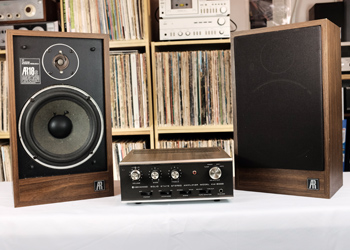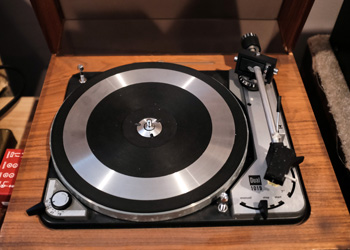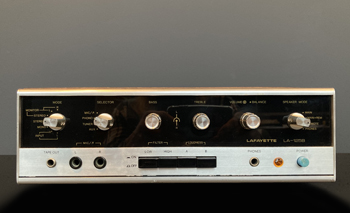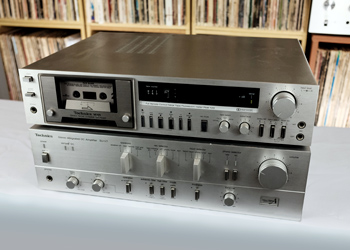Budget Silver Era Components: The Triumph Of Mid-Fi
After 1965, the explosion of popular music and the arrival of budget-priced classical music recordings combined to generate a huge demand for quality stereo systems that were reasonably priced and accessible to the mass market, not just audio hobbyists. As higher power amplifiers, quality turntables and changers and sensitive FM tuners became readily available, music lovers in the early 1970s could enjoy a greatly improved listening experience at an affordable price.
Reel to reel tape recorders graced more and more systems as the large and heavy tape recorders of the early 1960’s began to shrink in size and price. Sales of ¼ track prerecorded tapes boomed and manufacturers made a concerted effort to develop small, low priced tape decks for the fast growing consumer market. By 1965-1968 you could add a decent stereo tape deck (usually made by Sony) to any system for the relatively modest price of $200.
The explosive popularity of rock music that began in 1962 with The Beatles brought large numbers of young consumers into a market that had previously been dominated by middle-aged audiophiles and DIY hobbyists. Thanks to solid-state electronics, hi-fi components were becoming less expensive, lighter in weight and more reliable. As high fidelity music reproduction became a major part of everyday middle-class life, the audio industry responded with affordable components that have proved to be extraordinarily appealing both for their mid-century styling and for their lovely analog sound.
For the past twelve years we have been accumulating and testing vintage systems that represent the affordable entry-level to serious listening experiences --what I like to refer to as Mid-Fi. These were well-built components that escaped from the constraints of low cost and low power. They were able to deliver a truly satisfying listening experience to most listeners for a very reasonable price.
As a rule these components did not aspire to the highest levels of fidelity but instead they were designed and manufactured with an artful blend of compromises. Given their relatively low cost and minimal features, they generally exceeded expectations, impressing even the critical listeners and magazine reviewers who were used to the more expensive equipment that had traditionally defined High Fidelity.
The new market for affordable High Fidelity was largely sparked in the late 1950s and early 1960s by a series of remarkable products from the New England companies, KLH and Acoustic Research. First came their revolution in speaker design, the acoustic suspension “bookshelf” speakers in the late 1950s. These were followed by the introduction of dome tweeters in 1958 and the introduction of transistorized components in 1962.
High Fidelity for the masses can be said to have begun 1962 with first widely marketed component to take advantage of newly developed solid-state electronics – the revolutionary KLH Model Eleven Portable Phonograph. That same year Acoustic Research introduced its equally revolutionary turntable. By 1965 affordable FM tuners, high fidelity FM table radios, modular FM/phono systems and wonderful bookshelf speakers were commonplace along with quality record changers, turntables and tape decks. In the 1960s many manufacturers began to further simplify stereo systems by combining various components in a single chassis. A prime example of this was the tuner/preamp/power amp combination – the receiver- which came to dominate dominate the market in the 70s and 80s.
The masters of minimalist simplification were KLH, whose Integrated Music Systems became the market leader for that critical decade of the 1960s, delivering quality sound with no technical complications. For the first time you could own a system with excellent fidelity which was easy to buy, hook-up and operate. Clad in walnut cabinets, with minimal controls, these compact systems with bookshelf speakers looked good in most mid-century settings and consumers loved the way they sounded.
It is reported that KLH sold close to 500,000 modular units between between 1965 and 1971. Along with KLH’s wildly popular Model Eleven portable phonograph and Model Twenty One table radio, these were the simple, attractive and modestly priced compact systems that graced countless college dorm rooms, apartments and middle-class homes in the years when “stereo” became an integral part of mainstream culture.
By 1966, KLH and Acoustic Research together accounted for about ½ of US speaker sales. Their dominance was challenged a few years later by Dynaco who sold approximately one million A-25 speakers between 1969 and 1976 and by Henry Kloss’ equally successful Advent speakers. Truly affordable Hi-Fi for the masses was a reality in the 1970s.
American home audio sales grew steadily throughout the 1970s but by the end of the decade, manufacturing was increasingly dominated by Japanese companies. Back in 1958 when they first entered the US market with Americanized names such as Superscope, Concord and Roberts, few could imagine that within 20 years many of the leading American brand names would be manufactured in Japan.
A very different “high tech” design aesthetic took hold in the 1980s and equipment became increasingly complex with black supplanting silver as the dominant color. With the coming of integrated circuits in the 1980s most audio products entered into an age of mass production for a huge consumer market and build quality declined. Lots of features and cheap construction became the norm.
Yet even amidst this general decline in quality construction and the accompanying obsession with a multitude of features and cluttered appearance, several mass market Japanese companies displayed their skill at turning out select products whose design, build quality and performance were of a level far beyond the norm for these years. Most of these higher priced models became classics, highly sought after 40 years later.
At the same time, their experiments with new designs for compact systems produced some of the most unique and appealing products since the heyday of KLH. Small in size they were perfectly suited to the Japanese homes where space was at a premium. They had a more difficult time in the American market.
Despite some limited success, in time most American buyers wanted bigger and better components and speakers, not miniatures. The first mini-components (1978-1982) were superbly engineered but the US market by and large wanted the audio equivalent of an SUV instead of a sub-compact. These wonderful mini-components are featured in the Maximum Performance section of our Low End & Mid Fi Mini Systems pages. After a few years manufacturers stopped selling the better mini-systems in the US and instead flooded the market with low priced compact systems with lots of features and quality that ranged from poor to mediocre.
In the mid-1990s, Panasonic, JVC, Sony and Denon tried to revive high quality miniature systems, this time incorporating CD players. After a brief burst of popularity these so-called “executive systems” vanished from the market and for many years thereafter compact systems remained solidly in the pit of mediocrity.
But for now let’s go back to the beginning of the 1970s when a wonderful array of full size components came to market in what came to be known as “The Silver Era.” The most basic amplifiers and receivers from the big name manufacturers boasted ample power to drive most speakers. Wonderful and affordable speakers were plentiful. Low priced, good quality turntables proliferated but increasingly consumers turned to the convenience of cassette tape. Home cassette decks rivaled or exceeded the quality of the inexpensive open reels and the cassette reigned supreme in both portable and automotive applications.
The Budget Silver Era Components pages that follow consist of 3 sections. Amplifiers & Receivers discuss the control and power components while Speakers and Auxiliary Components discuss speaker options and other gear such as CD players, cassette decks and turntables.
These pages present some of the best of these affordable components that brought good audio to the mass market in the 1970s. For almost 15 years these dominated consumer audio. There are good reasons why they’ve never lost their value and appeal, while so many of the affordable designs that came after the early 1980s are nearly worthless today.

AR-18

Dual 1

KLH New Shape

Lafayette LA-125B

